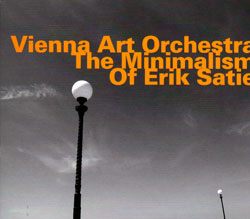
The powerful Vienna Art Orhestra called it a day last year after 33 years of presenting bold (underscore, bold) orchestral arrangements of canonical jazz and classical works. Under Mathias R�egg's leadership, the ensemble brought new life to the compositions of Duke Ellington and Charles Mingus, Giuseppe Verdi and Johann Strauss, and was named Cultural Ambassadors of the Republic of Austria in the process.
The Minimalism of Erik Satie is a 1994 recording by the earliest incarnation of the ensemble, a larger group than the 1992 lineup and including (most prominently) vocalist and co-founder Lauren Newton. It's a fascinating take on Satie and his love for incidental, or "background," music, one that would fall flat if it weren't so good. R�egg's arrangements have an Ellingtonian sweep while managing to retain some feeling of the stillness in Satie's music. He takes on Satie's diminutively elegant Gnossienne piano pieces in a seemingly counterintuitive (and certainly jazz-minded) manner, treating them as themes to be varied, even adding an Arabesque in Reflections on Gnossienne No. 1 reminiscent (not to belabor the Duke parallel, but it's so strong) of Ellington's Far East Suite.
The boldest section of the CD, recently reissued by hatOLOGY, comes in the last three tracks (making up more than half the 75-minute playing time). After meditating on Satie's miniatures, they approach the massive (yet still minimalist) Vexations. There is some controversy around the piece, and Satie's intentions aren't clear. It wasn't published during his lifetime (John Cage was responsible for the first publication in 1949 and for the first "full" performance in 1963). The piece is made up of a repeating melody line in the bass register, sometimes with chordal accompaniment in the treble. The manuscript score is a single page, but it bears the instruction "in order to play the theme 840 times in succession, it would be advisable to prepare oneself beforehand, and in the deepest silence, by serious immobilities." That inscription has generally been taken to mean that the piece should be played 840 times, a feat that takes approximately 18 hours, although the 840 successions isn't strictly stated by Satie, and in fact some historians have maintained that the piece was simply meant as a joke.
The VAO members do three realizations of the piece (which are also the only non-R�egg arrangements on the album), each paring vibraphonist Woody Schabata with a different soloist. Saxophonist Roman Schwaller plays a quiet interpretation, bridging the jazzier first half of the program into the quietly plaintive Vexations variations. Newton's vocal treatment is probably the most engaging of the three, a slowly but endlessly varying exploration. Wolfgang Puschnig's 23-minute bass clarinet reading is by far the longest and makes for a strikingly beautiful close to the record.
To classical purists, the jazzy approach to the record may run counter to the composer's spirit. But Satie was a lover of early jazz and despised notions of "high art." More to the point, The Minimalism of Erik Satie is far from some ill-conceived Schwinging with Stockhausen affair. It is interpretation, it is by a jazz orchestra, and it is ultimately both faithful and inventive.
Comments and Feedback:
|



